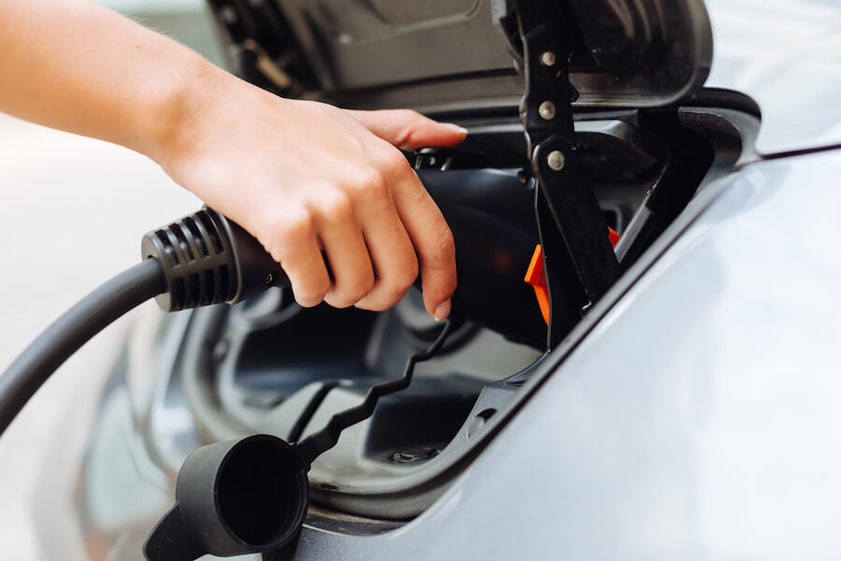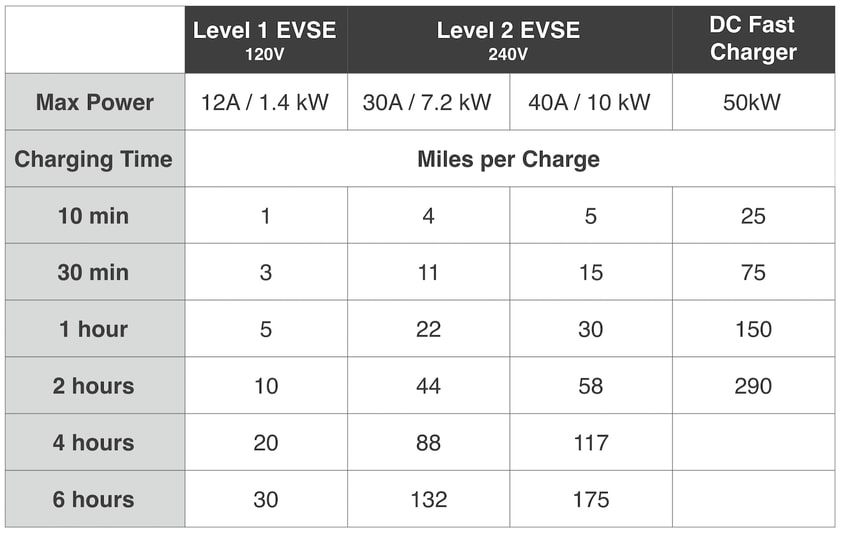How Long Does it Take to Charge an Electric Car?

It’s time to get a new car and you’ve been hearing and reading a lot about electric cars lately, so you’re wondering if getting one is the right decision for you. You might have common questions like: how long does it take to charge an electric car, how long does an electric car battery life last, or how much does it cost to charge an electric car at public charging points? There are many good reasons to consider switching to electric drive for your next car like: the environmental benefits, cutting edge technology such as self-driving, the smooth & quiet driving experience and the instant torque that only an electric motor can provide. However, one of the best reasons is often overlooked, and that’s how inexpensive an electric plug-in car can be to own.
Electricity Costs: How Much Does it Cost to Charge an Electric Car?
As with gasoline cars, some plug-in electric vehicles are more efficient than others, and the average EV needs about 30 kWh of electricity to power the vehicle for 100 miles. For example, the EPA rating for a 2018 Nissan LEAF is exactly 30 kWh per 100 miles. A Tesla Model X 75D is rated at a combined 36 kWh per 100 miles, and uses more energy since it’s larger, heavier and more powerful than a LEAF. The Hyundai Ioniq is currently the most efficient electric plug-in car, and has a combined consumption rating of only 25 kWh per 100 miles. For a list of current electric vehicles with side by side comparisons for all electric car efficiency, visit the US Department of Energy’s website: www.fueleconomy.gov
The cost of electricity throughout the U.S. varies greatly, however over time the cost is much more stable. Currently, the electric rates are the highest in Hawaii, at about 32 cents per kWh, and the lowest in the state of Washington, where it costs only 9.65 cents per kWh. Unlike in gasoline prices, there aren’t huge spikes in electricity rates if a refinery has a problem, and neither does the price skyrocket when there is political instability in one of the large oil producing countries. All of the electricity we use in America is domestically produced, and that’s a large part of why the cost remains stable.
Overall, the average cost of electricity in the U.S. is 12 cents per kWh. Therefore, the average person driving the average EV 12,000 miles per year pays about $432.00 per year to charge it. As mentioned, the cost of electricity can vary greatly depending on where you live, but in order to equal the price of the average gasoline car’s fuel costs, the price of electricity would have to be about 3 times the current national average. It’s a simple fact, the electric car cost per mile is substantially lower than it is for a gasoline or diesel car.
Maintenance Costs for Electric Cars
And the savings with plug-in vehicles don’t stop with gas. With fewer moving parts, EV drivers can attest that EV cars cost much less to maintain. Forget the oil changes, tune-ups, fuel filters, timing belts new mufflers, etc. EV cars are basically just plug and play, and require at most an annual check-up, just to make sure everything is OK. If you combine the fuel savings of electric cars vs gas, along with the reduced maintenance costs, it’s clear to see an EV car will cost you much less in the long run, even if it costs a little more upfront. If you’re wondering how much does it cost to charge an electric vehicle at public charging points, that answer is a little more complicated, since the owner of the public charging station can set any rate they want. Some stations are actually free to use, and others usually charge by the hour. However, the vast majority of EV drivers charge from a home charging station and pay what their utility charges.
So How Long Does it Take To Charge an Electric Car?
Now that you know electric cars cost much less than gas cars to refuel and maintain, let’s address the “how long to charge an electric car” question. With a quick look at the online forums and EV discussion boards, you’ll see people asking questions like “how long does it take to charge using a Nissan LEAF home charger” or “how long does it take to charge a Tesla?” Different plug-in vehicles take varying lengths of time to charge, depending on three factors:
1) the size of the car’s battery, also referred to as the battery capacity
2) The charging source’s power output (ie. How strong is the charging station)
3) the rate of charge the car is capable of accepting
Without knowing all three of these factors, it’s not possible to answer the question accurately. So unfortunately, the question of how long to charge an electric vehicle cannot be answered without knowing the specific information relative to your EV car, and your power source. The best place to get that information is to reference on the manufacturer’s website.
The type of EV charger can give you a rough estimate on general EV charging time.
- • Level 1 120-volt charging power will deliver about 3-5 miles of range per hour of charging.
- • Level 2, 240-volt charging power will add between 15 and 40 miles of range per hour of charging.
- • Level 3 - 120-150 miles of range per hour, but requires considerable installation requirements.
The slower rate of level 1 charging means that electric car drivers typically have to charge their vehicles overnight, as fast charging is not an option. Level 2 chargers are considered the sweet spot when it comes to EV charging equipment as they are easy to install and have great power output. If you’re shopping for a Level 2 home charging station, make sure you don’t make the mistake of getting a low-powered unit, that can take very long to charge your car's battery. Level 3 chargers, also known as DC fast chargers, have the highest power output (120-150 miles of range per hour), but unfortunately, most homes’ electrical systems are unable to handle the power strain. Level 3 chargers require a complex installation process and for this reason, we do not recommend DC charging. Not sure what level you have? Check out our post on the different EV Charging Levels.
It’s advisable to consider getting a charging station that can deliver at least 32-amps. A 40-amp unit will future-proof your investment, and might be the best solution, even if your current EV doesn’t accept 40-amps.

Leverage Time of Use Programs
Finally, another way to save money with an EV car is to take advantage of your utility company’s Time Of Use (TOU) programs, if offered. These programs allow electric car drivers to charge their cars during off-peak hours at a dramatically lower electricity rate. Some TOU rates are two-thirds to three-quarters lower than the full peak hour rates, so make sure you know your electricity providers rate plans, and choose the one that suits your needs best. However, keep in mind that if you switch to TOU using electricity during peak hours is more expensive, so you may need to adjust your consumption habits such as running the dishwasher in the morning vs. evenings.
Installing a smart EV home charger like the JuiceBox Pro 40 level 2 charging station can be an advantage, as it allows the owner to program the unit to take advantage of their utility’s TOU rates, and save even more money. With the use of a level 2 charging station, charging an electric vehicle is quick, inexpensive and easy. Shop home charging stations today!







